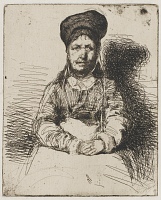Etchings Institutions search term: grolier club
La Rétameuse | ||
| Number: | 26 | |
| Date: | 1858 | |
| Medium: | etching | |
| Size: | 112 x 89 mm | |
| Signed: | 'Whistler.' at lower right (2) | |
| Inscribed: | 'Imp. Delatre. Rue St. Jacques. 171.' at lower left (2) | |
| Set/Publication: | 'French Set', 1858 | |
| No. of States: | 2 | |
| Known impressions: | 42 | |
| Catalogues: | K.14; M.11; T.3; W.5 | |
| Impressions taken from this plate (42) | ||
KEYWORD
TITLE
'La Rétameuse' (1858, Whistler). 1
'La Rétameuse -' (1870/1874, Whistler). 2
'La Rétameuse' (1874, Ralph Thomas, Jr (1840-1876)). 3
All later cataloguers used Whistler's original title, 'La Rétameuse'.
1: Published in Douze eaux-fortes d'après Nature (Twelve Etchings from Nature).
3: Thomas 1874 (cat. no. 3).
DESCRIPTION
SITTER
'She sat, with one foot upon a treadle, by bearing down upon which, an opening was made between the threads of the warp, throwing one half of them up, and the other half down, so that the shuttle could pass between them. She then pushed the shuttle through, and caught it in on the other side. By moving the treadle again, the order of the threads in the warp was reversed, so that those threads which were up before were down now, and the shuttle was then thrown back.... The threads which make the length of the cloth are called the warp. They are stretched evenly across the loom, and wound round a beam, which revolves as the loom works, and lets off just as much, each turn, as is wanted. The threads that run across are called the filling, which is contained in the shuttle, and unwound as the shuttle passes back and forth through the warp... "Yes, dear grandpa," said I, "but our factories are much better. They can make a hundred, or, perhaps, a thousand, while grandmother would make one."' 4
4: Anon. ('Margaret'), 'Old times and new', Robert Merry's Museum, August 1858, pp. 49-53, accessed in http://www.merrycoz.org (2009).
Apart from weaving, the other main use for a shuttle was in making nets. Alfred Stieglitz's photogravure, Mending Nets, shows a woman mending a net near Katwiyk, in the Netherlands; her bonnet, like that of the La Rétameuse, is set back on her head, with a high gathered crown encasing her hair, and ribbons dangling loose at each side. This was in 1894, many years after Whistler's etching, but in an area where traditional dress was still common. 7
However, despite this similarity in headgear, it is more likely that the sitter was engaged in hand-loom weaving than net-making, just because Whistler spent very little time on the coast in 1858 (though he would probably have passed through Dieppe).
5: Group conversing [m0241].
6: Elsass und Lothringen (printed in border, 'Alsacia and Loraine'), lithographed by Max Tilke, from Heyck, Eduard, and Rosenberg, Adolf, Geschichte des kostüms (Berlin: Wasmuth, 1905-1923), in NYPL, Call No. PC COSTU-Reg-Fr.
7: Camera Notes, Vol. II, no. 3, January, 1899, p. 108.
DISCUSSION
8: Lochnan 1984 , p. 28.

